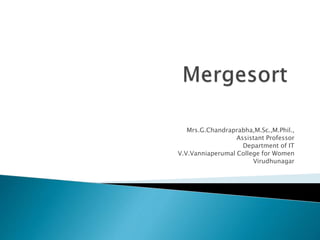Mergesort
•Download as PPT, PDF•
0 likes•48 views
Sorting n-numbers using merge sort to implement Divide and Conquer approach.
Report
Share
Report
Share

Recommended
More Related Content
What's hot
What's hot (20)
An improvement in k mean clustering algorithm using better time and accuracy

An improvement in k mean clustering algorithm using better time and accuracy
A Variant of Modified Diminishing Increment Sorting: Circlesort and its Perfo...

A Variant of Modified Diminishing Increment Sorting: Circlesort and its Perfo...
"k-means-clustering" presentation @ Papers We Love Bucharest

"k-means-clustering" presentation @ Papers We Love Bucharest
Similar to Mergesort
Similar to Mergesort (20)
Bidirectional Bubble Sort Approach to Improving the Performance of Introsort ...

Bidirectional Bubble Sort Approach to Improving the Performance of Introsort ...
More from V.V.Vanniaperumal College for Women
More from V.V.Vanniaperumal College for Women (20)
Recently uploaded
Recently uploaded (20)
Integrating Telephony Systems with Salesforce: Insights and Considerations, B...

Integrating Telephony Systems with Salesforce: Insights and Considerations, B...
Free and Effective: Making Flows Publicly Accessible, Yumi Ibrahimzade

Free and Effective: Making Flows Publicly Accessible, Yumi Ibrahimzade
How Red Hat Uses FDO in Device Lifecycle _ Costin and Vitaliy at Red Hat.pdf

How Red Hat Uses FDO in Device Lifecycle _ Costin and Vitaliy at Red Hat.pdf
Introduction to Open Source RAG and RAG Evaluation

Introduction to Open Source RAG and RAG Evaluation
SOQL 201 for Admins & Developers: Slice & Dice Your Org’s Data With Aggregate...

SOQL 201 for Admins & Developers: Slice & Dice Your Org’s Data With Aggregate...
ASRock Industrial FDO Solutions in Action for Industrial Edge AI _ Kenny at A...

ASRock Industrial FDO Solutions in Action for Industrial Edge AI _ Kenny at A...
Intro in Product Management - Коротко про професію продакт менеджера

Intro in Product Management - Коротко про професію продакт менеджера
Choosing the Right FDO Deployment Model for Your Application _ Geoffrey at In...

Choosing the Right FDO Deployment Model for Your Application _ Geoffrey at In...
Introduction to FDO and How It works Applications _ Richard at FIDO Alliance.pdf

Introduction to FDO and How It works Applications _ Richard at FIDO Alliance.pdf
PLAI - Acceleration Program for Generative A.I. Startups

PLAI - Acceleration Program for Generative A.I. Startups
UiPath Test Automation using UiPath Test Suite series, part 2

UiPath Test Automation using UiPath Test Suite series, part 2
What's New in Teams Calling, Meetings and Devices April 2024

What's New in Teams Calling, Meetings and Devices April 2024
Secure Zero Touch enabled Edge compute with Dell NativeEdge via FDO _ Brad at...

Secure Zero Touch enabled Edge compute with Dell NativeEdge via FDO _ Brad at...
Optimizing NoSQL Performance Through Observability

Optimizing NoSQL Performance Through Observability
Mergesort
- 1. Mrs.G.Chandraprabha,M.Sc.,M.Phil., Assistant Professor Department of IT V.V.Vanniaperumal College for Women Virudhunagar
- 2. Sorting refers for arranging elements in an either ascending or descending order. Sorting algorithms which include Insertion, selection and bubble sort can have quadratic time algorithms and they have worst-case performance The faster comparison based algorithm is needed with time complexity O(nlogn) Example: Merge sort and Quick sort
- 3. Apply divide-and-conquer approch for this sorting problem Problem: Given n elements, sort elements into non-decreasing order Divide-and-Conquer: ◦ If n=1 terminate (every one-element list is already sorted) ◦ If n>1, partition elements into two or more sub- collections; sort each; combine into a single sorted list How do we partition? Here three options are used for partition.
- 4. First n-1 elements into set A, last element set B Sort A using this partitioning scheme recursively ◦ B already sorted Combine A and B using method Insert() ( insertion into sorted array) Leads to recursive version of InsertionSort() ◦ Number of comparisons: O(n2) Best case = n-1
- 5. Put element with largest key in B, remaining elements in A Sort A recursively To combine sorted A and B, append B to sorted A ◦ Use Max() to find largest element recursive SelectionSort() ◦ Use bubbling process to find and move largest element to right-most position recursive BubbleSort() All O(n2)
- 6. Let’s try to achieve balanced partitioning A gets n/2 elements, B gets rest half Sort A and B recursively Combine sorted A and B using a process called merge, which combines two sorted lists into one
- 7. Partition into lists of size n/2 Here n=8 [10, 4, 6, 3] [10, 4, 6, 3, 8, 2, 5, 7] [8, 2, 5, 7] [10, 4] [6, 3] [8, 2] [5, 7] [4] [10] [3][6] [2][8] [5][7]
- 8. Merge [3, 4, 6, 10] [2, 3, 4, 5, 6, 7, 8, 10 ] [2, 5, 7, 8] [4, 10] [3, 6] [2, 8] [5, 7] [4] [10] [3][6] [2][8] [5][7]
- 9. Public static void mergeSort(Comparable []a, int left, int right) { // sort a[left:right] if (left < right) {// at least two elements int mid = (left+right)/2; //midpoint mergeSort(a, left, mid); mergeSort(a, mid + 1, right); merge(a, b, left, mid, right); //merge from a to b copy(b, a, left, right); //copy result back to a } }
- 10. Recurrence equation Assume n is a power of 2 c1 if n=1 T(n) = 2T(n/2) + c2n if n>1, n=2k TmergeSort(n) is O(nlogn)
